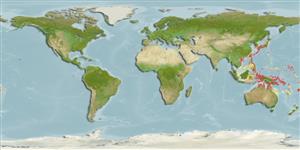Environment: milieu / climate zone / depth range / distribution range
Ecologia
marinhas associadas(os) a recifes; intervalo de profundidade 0 - 20 m (Ref. 93839). Tropical
Western Pacific: southern Japan south to the Coral Sea.
Tamanho / Peso / Idade
Maturity: Lm ? range ? - ? cm
Max length : 10.0 cm TL macho/indeterminado; (Ref. 2334); common length : 8.0 cm SL macho/indeterminado; (Ref. 37816)
Espinhos dorsais (total): 8; Raios dorsais moles (total): 9; Espinhos anais 2; Raios anais moles: 8. Characterized by having a black band from the snout to the eye; distinct spot on nape; black spot on caudal fin base; black blotch on the first dorsal fin distally; blackish bands along the bases of the second dorsal and anal fins (Ref. 93839).
Occur in groups around coral bommies (Ref. 2334). In Japan, the breeding season is from June to September. Breeding pairs set up territory which is mostly defended by the female (Ref. 57690). Mouthbrooding is done by the male parents (Ref. 559 and 637) some of which resort to partial egg cannibalism probably to adjust the brood size to their buccal capacity (Ref. 57690). Nocturnal species, but courtship and spawning takes place during day (Ref. 7300, 37227, 38747).
Clutches of eggs from a single female are mouthbrooded by males (Ref. 57684). Distinct pairing (obligate monogamy) during courtship and spawning (Ref. 205, 52884). Multiple spawner with 10-19 days interval between matings (Ref. 38747). Females attack conspecifics during courtship (Ref. 57684). The operational sex ratio is male biased all throughout the breeding season primarily due to a higher mortality in females, thus sex-role reversal is not predicted for this species (Ref. 57684).
Randall, J.E., G.R. Allen and R.C. Steene, 1990. Fishes of the Great Barrier Reef and Coral Sea. University of Hawaii Press, Honolulu, Hawaii. 506 p. (Ref. 2334)
Categoria na Lista Vermelha da IUCN (Ref. 130435)
Ameaça para o homem
Harmless
Utilização humana
Mais informação
ReferênciasAquaculturaPerfil para aquaculturaEstirpesGenéticaElectrophoresesHereditariedadeDoençasProcessamentoNutrientsMass conversion
ColaboradoresFotografiasStamps, Coins Misc.SonsCiguateraVelocidadeTipo de nataçãoÁrea branquialOutras referênciasCérebrosVisão
Ferramentas
Relatórios especiais
Descarregue XML
Fontes da internet
Estimates based on models
Preferred temperature (Ref.
123201): 21.5 - 29.3, mean 28.4 °C (based on 1585 cells).
Phylogenetic diversity index (Ref.
82804): PD
50 = 0.5000 [Uniqueness, from 0.5 = low to 2.0 = high].
Bayesian length-weight: a=0.01288 (0.00551 - 0.03009), b=3.10 (2.92 - 3.28), in cm total length, based on LWR estimates for this Genus-body shape (Ref.
93245).
Nível Trófico (Ref.
69278): 3.5 ±0.50 se; based on food items.
Resiliência (Ref.
120179): Médio, tempo mínimo de duplicação da população 1,4 - 4,4 anos (Fec=3,315).
Fishing Vulnerability (Ref.
59153): Low vulnerability (10 of 100).
Nutrients (Ref.
124155): Calcium = 148 [73, 243] mg/100g; Iron = 0.996 [0.568, 1.740] mg/100g; Protein = 18.6 [17.4, 19.8] %; Omega3 = 0.123 [0.068, 0.217] g/100g; Selenium = 29.4 [14.9, 58.0] μg/100g; VitaminA = 57.6 [16.8, 200.3] μg/100g; Zinc = 1.76 [1.14, 2.64] mg/100g (wet weight);
